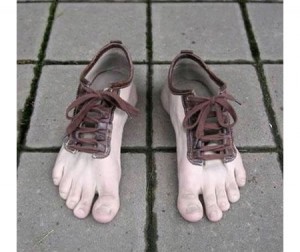One of the most common PT clients I see is an injured runner. There can be a umber of different reasons or factors involved leading up to a running injury, but I wanted to focus on this idea of gait retraining that is taking place today. With the advent of Born to Run and minimalist footwear, people have begun to question and debate what the best way to run is.

Is this suited for everyone?
Let me just say right away that I do not believe there is a simple answer here. Human beings are all unique and have different genetic and biomechanical makeups. What this means in effect is that they have their own set of “issues” if you will that I classify into common categories such as:
- Static alignment problems (arch, knee, hip, etc)
- Static and dynamic balance deficits
- Inefficient gait mechanics
- Muscle imbalances
- Soft tissue tightness
- Recurring pain patterns
The list could go on and on, but you get the point. The idea of “re-teaching” someone how to run differently than their natural motor pattern dictates in not easy and is a decision that should be well thought out and based on sound decision making. We are pre-programmed at birth with certain native motor patterns and running is one of those patterns. Generally, your brain finds the most efficient way for you to run in your own body.

Now granted, some run much better than others. Perhaps we can say athleticism plays a role in this, but as we grow and reach skeletal maturity our body type, training experience, strength and environment are also major factors . With that said, I know that runners with recurrent and/or chronic pain are looking for a finite solution to their problem. They grow frustrated when they are unable to log all their miles or finish a race.
If traditional PT or relative rest fails to alleviate the pain, we must delve deeper and look more closely at their gait. I think video analysis is a great tool for doing this. We use Dartfish at my clinic, and this is very useful for breaking down gait mechanics and detecting things like heel versus forefoot striking, overpronation, asymmetry side-to-side, trunk inclination, etc. Once we find things on video we must also correlate these findings to our clinical screening to uncover a cause and effect relationship.
I like to use the FMS as well as some other clinical tests to gather a baseline of information before putting people on the treadmill. Then, I put my runners on the treadmill and look for predictable patterns of movement or flaws based on those initial findings. The important thing to remember is there are not always clear cut mechanical flaws, and sometimes things on the clinical side don’t carry over to the running form (e.g. flat arches do not always show up as overpronation during running).
One popular trend in the running community is to move away from heel striking and land more on the midfoot or forefoot.

The thinking is this will reduce ground reaction forces on the knee and perhaps eliminate anterior knee pain. A case study in JOSPT looking at 3 women who were heel strikers (all with unilateral patellofemoral pain) revealed that with gait retraining over 8 sessions they all had diminished pain and better function. They were also able to maintain their new strike pattern up to 3 months after the training. Click here to read the abstract.
However, only 1 of the 3 women reported better running performance. So, this begs the question of whether or not it is wise to change running form in non-injured runners looking to prevent injuries and/or improve running performance. This is a much more challenging question. While changing strike patterns may alleviate/reduce pain, can we be certain stride length, trunk lean or some other factor (s) are not just as important when making this landing adjustment?

At the end of the day, we must keep in mind that running form is complex and a very individual thing. Tweaking or changing your running form should not be a quick decision made without expert analysis and input regarding your training history, running goals and injury patterns. In my mind, the jury is still out on what, if any pattern is best for the performance side as well as injury patterns. Early research does look promising for shortening strides, attaining a slightly forward trunk inclination and perhaps shifting more toward a midfoot/forefoot strike pattern.
However, we need larger studies and more widespread data before trying to issue any blanket statements about the “ideal running form.” Remember that the body will naturally choose the path of least resistance (this is not always a good thing as it plays into compensations/weakness). Awareness of your “natural pattern” is a good starting place. Small corrections involving muscle imbalances, single leg strength, hip and core stability and arch support should all precede large mechanical changes in gait in those dealing with injuries.

There are lots of pieces to the running puzzle
In the end, running is still repetitive and single leg stance driven. Assessing and correcting side-to-side differences is a must as issues on one side often lead to compensation on the other. So, start with the small things first. I think as time goes by and we gather more data, there will be a better understanding of what general form patterns are best biomechanically to aid injured and non-injured runners alike. The question will always be how much do we choose to mess with nature?

